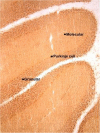Consensus Paper: Neuroimmune Mechanisms of Cerebellar Ataxias
- PMID: 25823827
- PMCID: PMC4591117
- DOI: 10.1007/s12311-015-0664-x
Consensus Paper: Neuroimmune Mechanisms of Cerebellar Ataxias
Abstract
In the last few years, a lot of publications suggested that disabling cerebellar ataxias may develop through immune-mediated mechanisms. In this consensus paper, we discuss the clinical features of the main described immune-mediated cerebellar ataxias and address their presumed pathogenesis. Immune-mediated cerebellar ataxias include cerebellar ataxia associated with anti-GAD antibodies, the cerebellar type of Hashimoto's encephalopathy, primary autoimmune cerebellar ataxia, gluten ataxia, Miller Fisher syndrome, ataxia associated with systemic lupus erythematosus, and paraneoplastic cerebellar degeneration. Humoral mechanisms, cell-mediated immunity, inflammation, and vascular injuries contribute to the cerebellar deficits in immune-mediated cerebellar ataxias.
Keywords: Anti-GAD antibodies; Cerebellar ataxias; Gluten ataxia; Hashimoto’s encephalopathy; Miller Fisher syndrome; Paraneoplastic cerebellar degeneration; Primary autoimmune cerebellar ataxia; Systemic lupus erythematosus.
Figures




References
-
- Charcot JM. Séance du 14 mars. CR Soc Biol (Paris) 1868;20:13.
-
- Vollmer TL, Waxman SG. Multiple sclerosis and other demyelinating disorders. In: Rosenberg RN, editor. Comprehensive neurology. New York: Raven; 1991. pp. 489–523.
-
- Brouwer B. Beitrag zur kenntnis der chronischen diffusen kleinhirnerkranghkungen. Neurol Centralbl. 1919;38:674–682.
Publication types
MeSH terms
Substances
Supplementary concepts
Grants and funding
LinkOut - more resources
Full Text Sources
Other Literature Sources
Medical

